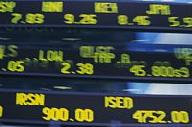
 |
|
| Financial Terms | |
| Gearing |
|
Information about financial, finance, business, accounting, payroll, inventory, investment, money, inventory control, stock trading, financial advisor, tax advisor, credit.
Main Page: inventory, credit, financial, payroll, stock trading, accounting, money, financial advisor, |
Definition of Gearing
GearingA measure of the extent of long-term debt in comparison with shareholders’ funds. GearingFinancial leverage.
Related Terms:Average (across-day) measuresAn estimation of price that uses the average or representative price of a Beta (Mutual Funds)The measure of a fund's or stocks risk in relation to the market. A beta of 0.7 means Beta equation (Mutual Funds)The beta of a fund is determined as follows: Changes in Financial PositionSources of funds internally provided from operations that alter a company's Coefficient of determinationA measure of the goodness of fit of the relationship between the dependent and Comparison universeThe collection of money managers of similar investment style used for assessing  Corporate financial managementThe application of Financial principals within a corporation to create and Corporate financial planningFinancial planning conducted by a firm that encompasses preparation of both Cost of fundsInterest rate associated with borrowing money. Country financial riskThe ability of the national economy to generate enough foreign exchange to meet Debt/equity ratioIndicator of Financial leverage. Compares assets provided by creditors to assets provided DebtMoney borrowed. Debt capacityAbility to borrow. The amount a firm can borrow up to the point where the firm value no Debt displacementThe amount of borrowing that leasing displaces. Firms that do a lot of leasing will be Debt instrumentAn asset requiring fixed dollar payments, such as a government or corporate bond.  Debt leverageThe amplification of the return earned on equity when an investment or firm is financed Debt limitationA bond covenant that restricts in some way the firm's ability to incur additional indebtedness. Debt marketThe market for trading debt instruments. Debt ratioTotal debt divided by total assets. Debt reliefReducing the principal and/or interest payments on LDC loans. Debt securitiesIOUs created through loan-type transactions - commercial paper, bank CDs, bills, bonds, and Debt serviceInterest payment plus repayments of principal to creditors, that is, retirement of debt. Debt service parity approachAn analysis wherein the alternatives under consideration will provide the firm Debt-service coverage ratioEarnings before interest and income taxes plus one-third rental charges, divided Debt swapA set of transactions (also called a debt-equity swap) in which a firm buys a country's dollar bank Debtor in possessionA firm that is continuing to operate under Chapter 11 bankruptcy process. Debtor-in-possession financingNew debt obtained by a firm during the Chapter 11 bankruptcy process. Deterministic modelsLiability-matching models that assume that the liability payments and the asset cash DisintermediationWithdrawal of funds from a Financial institution in order to invest them directly. Dividend yield (Funds)Indicated yield represents return on a share of a mutual fund held over the past 12 Dupont system of financial controlHighlights the fact that return on assets (ROA) can be expressed in terms Endowment fundsInvestment funds established for the support of institutions such as colleges, private Euro-medium term note (Euro-MTN)A non-underwritten Euronote issued directly to the market. Euro- Federal fundsNon-interest bearing deposits held in reserve for depository institutions at their district Federal Federal funds marketThe market where banks can borrow or lend reserves, allowing banks temporarily Federal funds rateThis is the interest rate that banks with excess reserves at a Federal Reserve district bank Financial analystsAlso called securities analysts and investment analysts, professionals who analyze Financial assetsClaims on real assets. Financial controlThe management of a firm's costs and expenses in order to control them in relation to Financial distressEvents preceding and including bankruptcy, such as violation of loan contracts. Financial distress costsLegal and administrative costs of liquidation or reorganization. Also includes Financial engineeringCombining or dividing existing instruments to create new Financial products. Financial futureA contract entered into now that provides for the delivery of a specified asset in exchange Financial intermediariesInstitutions that provide the market function of matching borrowers and lenders or Financial leaselong-term, non-cancelable lease. Financial leverageUse of debt to increase the expected return on equity. Financial leverage is measured by Financial leverage clienteleA group of investors who have a preference for investing in firms that adhere to Financial leverage ratiosRelated: capitalization ratios. Financial marketAn organized institutional structure or mechanism for creating and exchanging Financial assets. Financial objectivesObjectives of a Financial nature that the firm will strive to accomplish during the period Financial planA Financial blueprint for the Financial future of a firm. Financial planningThe process of evaluating the investing and financing options available to a firm. It Financial pressThat portion of the media devoted to reporting Financial news. Financial ratioThe result of dividing one Financial statement item by another. Ratios help analysts interpret Financial riskThe risk that the cash flow of an issuer will not be adequate to meet its Financial obligations. Firm's net value of debtTotal firm value minus total firm debt. Forward Fed fundsFed funds traded for future delivery. Funded debtdebt maturing after more than one year. Funds From Operations (FFO)Used by real estate and other investment trusts to define the cash flow from Graham-Harvey Measure 1Performance measure invented by John Graham and Campbell Harvey. The Graham-Harvey Measure 2Performance measure invented by John Graham and Campbell Harvey. The Highly leveraged transaction (HLT)Bank loan to a highly leveraged firm. Homemade leverageIdea that as long as individuals borrow (or lend) on the same terms as the firm, they can Interest rate on debtThe firm's cost of debt capital. Intermarket sectorspread The spread between the interest rate offered in two sectors of the bond market for Intermarket spread swapsAn exchange of one bond for another based on the manager's projection of a Intermediate-termTypically 1-10 years. IntermediationInvestment through a Financial institution. Related: disintermediation. Internal measureThe number of days that a firm can finance operations without additional cash income. Junior debt (subordinate debt)debt whose holders have a claim on the firm's assets only after senior LeverageThe use of debt financing. Leverage clienteleA group of shareholders who, because of their personal leverage, seek to invest in Leverage ratiosmeasures of the relative contribution of stockholders and creditors, and of the firm's ability Leverage rebalancingMaking transactions to adjust (rebalance) a firm's leverage ratio back to its target. Leveraged betaThe beta of a leveraged required return; that is, the beta as adjusted for the degree of Leveraged buyout (LBO)A transaction used for taking a public corporation private financed through the use Leveraged equityStock in a firm that relies on Financial leverage. Holders of leveraged equity face the Leveraged leaseA lease arrangement under which the lessor borrows a large proportion of the funds needed Leveraged portfolioA portfolio that includes risky assets purchased with funds borrowed. Leveraged required returnThe required return on an investment when the investment is financed partially by debt. Liquidity theory of the term structureA biased expectations theory that asserts that the implied forward London International Financial Futures Exchange (LIFFE)A London exchange where Eurodollar futures LongOne who has bought a contract(s) to establish a market position and who has not yet closed out this Long bondsBonds with a long current maturity. The "long bond" is the 30-year U.S. government bond. Long coupons1) Bonds or notes with a long current maturity. Long hedgeThe purchase of a futures contract(s) in anticipation of actual purchases in the cash market. Used Long positionAn options position where a person has executed one or more option trades where the net Long runA period of time in which all costs are variable; greater than one year. Long-termIn accounting information, one year or greater. Long-term assetsValue of property, equipment and other capital assets minus the depreciation. This is an Long-term debtAn obligation having a maturity of more than one year from the date it was issued. Also Long-term debt/capitalizationIndicator of Financial leverage. Shows long-term debt as a proportion of the Long-term debt ratioThe ratio of long-term debt to total capitalization. Long-term financial planFinancial plan covering two or more years of future operations. Long-term liabilitiesAmount owed for leases, bond repayment and other items due after 1 year. Long-term debt to equity ratioA capitalization ratio comparing long-term debt to shareholders' equity. Leveragehe use of debt financing. Leveraged portfolioA portfolio that includes risky assets purchased with funds borrowed. London International Financial Futures Exchange (LIFFE)London exchange where Eurodollar futures as well as futures-style options are traded. Long bondsBonds with a long current maturity. The "long bond" is the 30-year U.S. government bond. Related to : financial, finance, business, accounting, payroll, inventory, investment, money, inventory control, stock trading, financial advisor, tax advisor, credit. |